#a homo movie by Gregg araki
Explore tagged Tumblr posts
Text


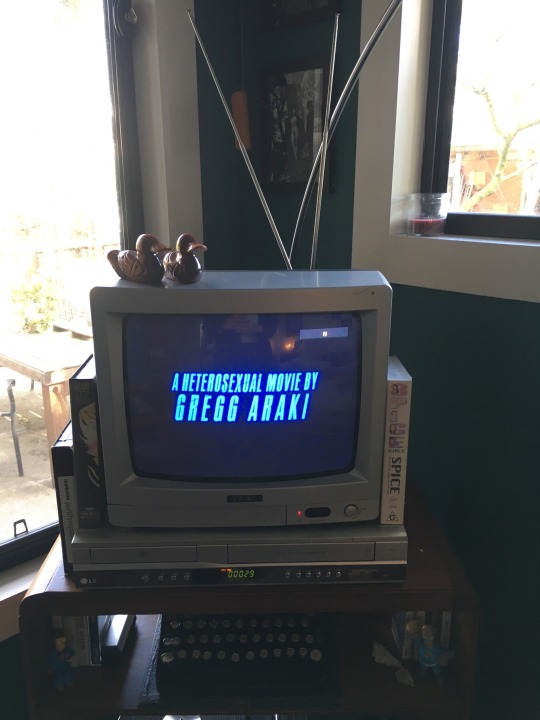

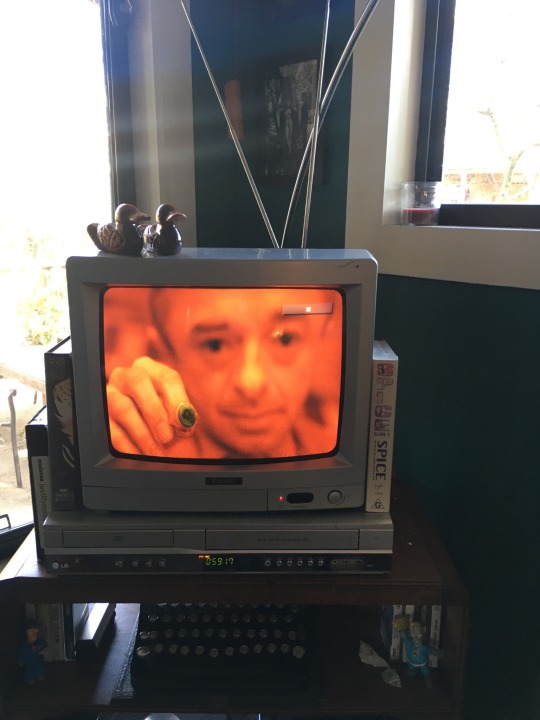
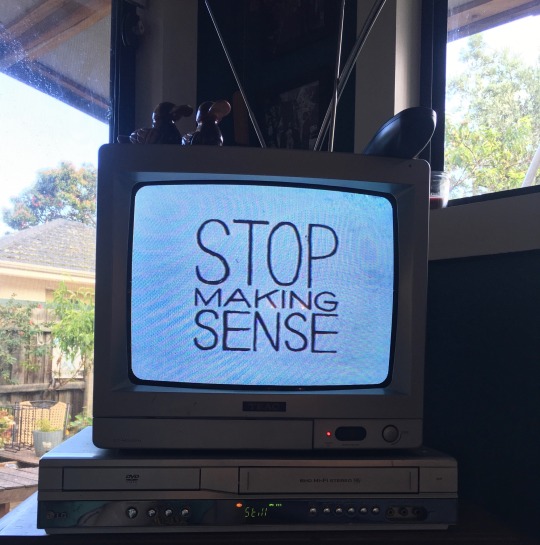
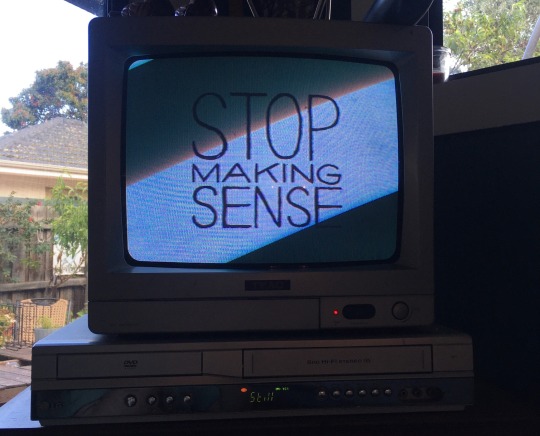
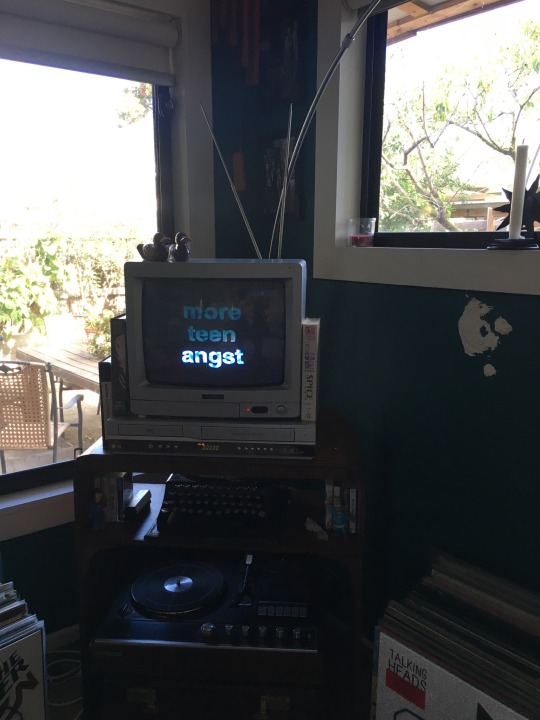

Some tv / movie title screens on my CRT tv
#twin peaks#fire walk with me#dale cooper#David lynch#David bryne#talking heads#Tina Weymouth#Gregg araki#totally fucked up#doom generation#punk#queer#crt#old tv#vintage#killing eve#villanelle#eve polastri#nowhere#a homo movie by Gregg araki#stop making sense
7K notes
·
View notes
Text

#the vaselines#alternative music#whisper#whispers#whisper girl#a homo movie by gregg araki#gregg araki#the doom generation#nowhere 1997#music#post punk#punk#punk rock
9 notes
·
View notes
Text
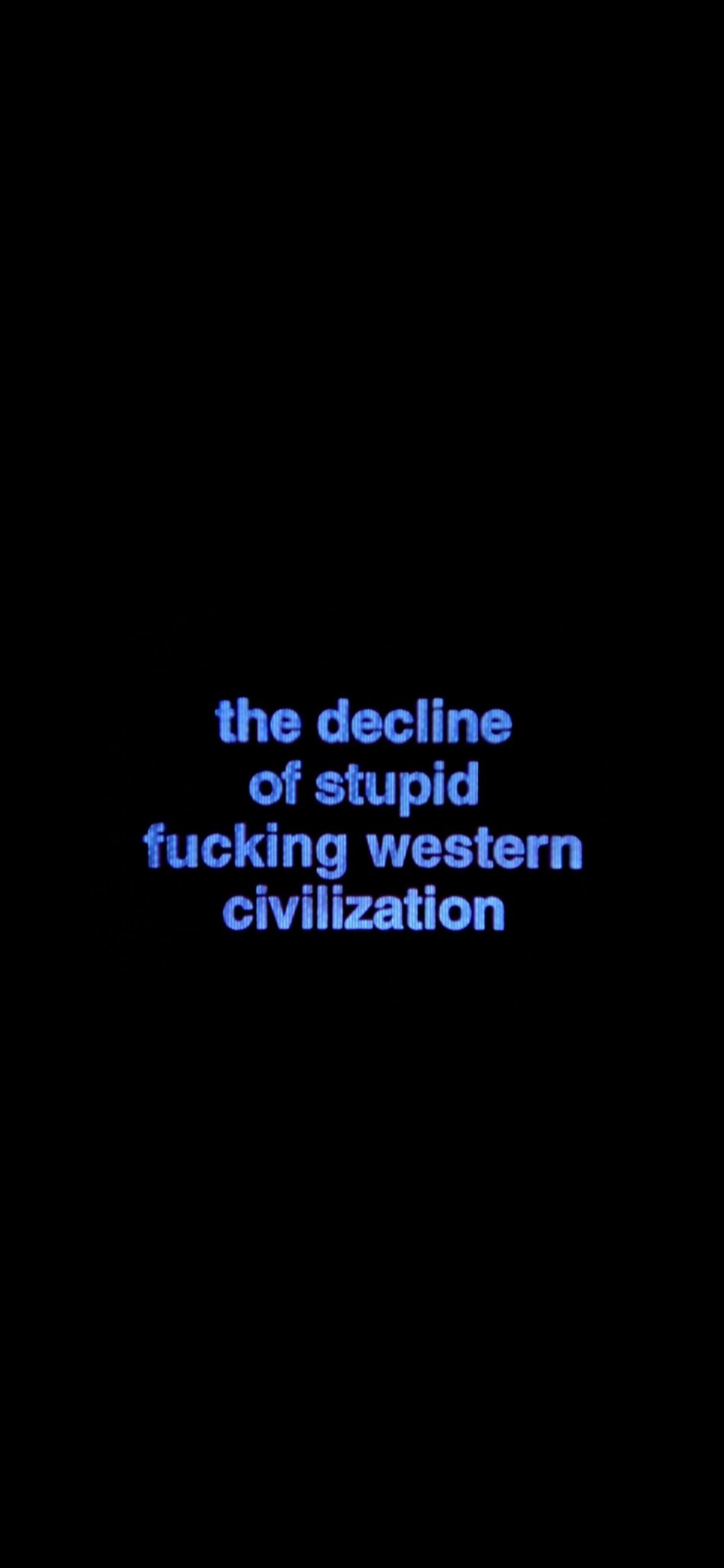
#gregg araki#james duval#nowhere#totally f***ed up#doom generation#mysterious skin#movies#another homo movie by gregg araki
35 notes
·
View notes
Text

hi
6 notes
·
View notes
Text

Another homo movie by Gregg Araki
3 notes
·
View notes
Text
The Doom Generation (1995)

Sometimes a narrative takes the term ‘story arc’ very literally. Amy and Jordan’s sudden and unexpected outlaw run is almost a perfect parabola, beginning in a nightclub called Hell and finishing in a uniquely American inferno. Gregg Araki attaches a disclaimer to his film at the outset, calling it ‘A Heterosexual Film’, but anything other than a very literal interpretation of the movie indicates this is a lie. Jordan and Amy have been together a long time as lovers—at least a few months—with Amy as headstrong and driven and Jordan just plain smitten, happy to be along for the ride. His puppy love is challenged as Xavier (just ‘X’; that name is too long to pronounce) crashes their ride and inserts himself into their lives. Crass and baudy at outset, he immediately gets on Amy’s bad side, though Jordan can’t help but defend him. Initially, their dynamic could play off as a lazy “no homo” gag: hanging out at the motel, the pair of young men are arranged in a will-they-won’t-they-kiss setup which is interrupted by that most bro-y of bodily movements, the belch. Jordan hastily retreats to mess around with his girlfriend in the tub while X looks on. Heteronormative order restored. Quickly enough, though, the dynamic is reversed with Jordan looking on in a mixture of jealousy and lust as he sees X being intimate with Amy. X begins to open up the sexuality of their ménage à trois, creating an environment for Jordan to explore his sexuality: is he jealous of X, or of Amy? Is she his lover or just the person who understands him the best? Who does he want? What does he want? The culminating threesome in many contexts could be a hollow or even chauvinist gesture: these two men want to fuck, but they’re using this woman as a shield to protect their own preconceived sexuality and masculinity. Yet there’s something about this moment, raunchy and yet intimate, which suggests the beginning of something new and honest. Amy gets her pleasure, but promptly and preemptively exits, leaving a black void between the two men who are gently bathed in firelight. Awkward words are exchanged, but will speech turn to action? Unfortunately, that’s where the rest of the movie comes crashing in.
This is, of course, a crime caper, and a damn fun one at that. This America in the mid-90s was an apocalyptic one, replete with billboards and placards assuring that the end is nigh. Every convenience store is armed to the teeth, and even a random drive-through exchange could end in gunfire. This trio leave behind them a trail of bodies and dismembered corpses as a result of their altercations with “normal America,” which becomes ever more cynical as implications set in. White news anchors speculate wildly about a murder scene involving a Vietnamese-American family (the husband given the intentionally inflammatory South Park tier name Nguyen Coc Suc). The religious fanaticism and conservatism implied by all of the doomsday posters is mocked by X, who has Jesus tattooed on his penis so partners can feel Him inside them. The burgeoning sexual freedom of this trio is such a threat that the FBI agents pursuing them are encouraged to kill if need be. It’s funny and it’s madcap. Severed limbs move long after they’ve left their respective bodies. American fast food fanaticism is mocked by Carnoburger’s disgusting menu and insane naming conventions. The thrupple end up at the most delightfully faggy Texas Roadhouse style establishment where EVERYONE has a wig and plastic six-pack rings hang from the ceiling like beaded curtains. Parker Posey makes a delightful cameo, not even bothering to hide her natural hairline under her wig as she delivers a master-class in the dramatic mid-sentence pause (shoutout also to Margaret Cho!). A national treasure. But all of this is ripped away in the final moments of the film. In almost any other movie, this wouldn’t work. The jerks from the record shop perform heinous acts, intermingling symbols of Americana with fascist hatred. It’s strobelit and jarring and shocking and upsetting, and all the better for it, in a subversive way. All of the rage over homophobic suppression of queer self-expression and health as the AIDS crisis raged unabated which is present in the periphery of the film, in its implication, bubbles to the surface in a final, nihilistic explosion. A heterosexual movie indeed.
THE RULES
PICK ONE
Select either FUCK or FUCKING and sip every time someone says that version of the word.
SIP
Someone lights a cigarette.
Someone fires a shotgun.
A dude recognizes Amy.
BIG DRINK
Jordan does his puppy-dog eyes thing.
An instance of 666 in some form.
#drinking games#the doom generation#gregg araki#james duval#rose mcgowan#johnathon schaech#crime#drama#romance#queer cinema#a heterosexual film lol#teenage apocalypse trilogy
10 notes
·
View notes
Text
ANALOG
1# Industrial and Sludge Fan

About Me:
He/It
I collect Cassettes, Records, and CDs
I'm @/HauntedGhosts on AOTY and Last.fm feel free to recommend me stuff to listen too :] I love doing music swaps
**There's a lot of flashing and possibly eyestrain-y stuff on here. Be careful**
Favorite Bands, Genres, and Movies under Read More
Genres:
Industrial, Sludge, Grunge, Noise, Folk Punk, Jazz Rap, Goth Rock, Shoegaze, Doom Metal, Crust Punk, New Wave, DnB, Drone Metal, Hardcore, Pigfuck, etc you probably get it by now
Favorite Bands:
Nine Inch Nails, REV CO., Ministry, Butthole Surfers, Nirvana, Melvins, Sonic Youth, Acid Bath, Eyehategod, Meat Beat Manifesto, Pixies, Dinosaur Jr, Dead Kennedys, 1000 Homo DJs, Bad Brains, Death(the black punk band not the thrash metal one), Medicine, The Jesus and Mary Chain, Soundgarden, Alice In Chains, Pavement, Hole, The Velvet Underground, The Violent Femmes, The Prodigy, Disgust, Mudhoney, The Cure, The Smiths, Nails, Terror, Discharge, Skunk, Portishead, Depeche Mode, Deftones, Digable Planets, Tyler The Creator, Siouxsie and the Banshees, Joy Division, The Smashing Pumpkins, Electric Wizard, Skatenigs, The Jesus Lizard, Noise Unit, Skinny Puppy, Acid King, Pailhead
^this isn't updated. go to my AOTY to see what I'm listening to (also just bc something isn't on there doesn't mean I don't listen to it.it just means I haven't finished the album ;-;)
Favorite Movies:
Literally Any Gregg Araki Movie, Slacker, Scream (1996), Ferris Bueller’s Day Off, Empire Records, Slacker, Pulp Fiction, Street Dreams, The Blair Witch Project (1999), Heathers, Cloverfield, Donnie Darko
7 notes
·
View notes
Text

youtube
Directed by Gregg Araki | 79 minutes | R 18+ | Opening Night
6.30pm, Friday, 17 November | Buy Tickets | Buy Passes
Another homo movie by Gregg Araki... screening from a newly restored, director-approved 2K scan.
Gay, alienated Los Angeles teens have a hard time as their parents kick them out of their homes, they don’t have money, their lovers cheat, and they are harassed by gay-bashers. Shot on 16mm film without permits, with virtually no crew, director Gregg Araki operated the camera himself, accompanied by only a sound person and producer/PA, and the cast. Araki's breakthrough fourth feature, the first installment in his Teenage Apocalypse trilogy and a seminal entry into the New Queer Cinema canon, premiered at the 1993 Sundance Film Festival.
“A rag-tag story of f*g-and-d*ke teen underground... a kind of cross between avant-garde experimental cinema and a queer John Hughes flick.” - Gregg Araki
RSVP on FB
Country: USA Year: 1993 Language: English
0 notes
Text

I think I found my soulmate.
(Andy from Totally Fucked Up)
#soulmate#Totally F***ed Up#totally fucked up#gregg araki#homo movie#andy#gay#love#homo#fucked up#love does not exist
6 notes
·
View notes
Text
" Another homo movie by gregg araki "





#movies#quotes#coming of age#gregg araki#totally fucked up#vintage 90s#90s films#90s movies#90s aesthetic
24 notes
·
View notes
Text
“Puts the Homo back in Homicide” is the teaser for Tom Kalin’s first feature, Swoon, but it could easily apply to Gregg Araki’s newest, The Living End, as well. Where Kalin’s film was an interrogation of the past, Araki’s is set resolutely in the present. Or is it? Cinematically, it restages the celluoid of the 1960s and 1970s: early Godard, Bonnie and Clyde, or Badlands— every pair-on-the-run movie that ever penetrated Araki’s consciousness. Here, though, the couple are both guys and they are HIV-positive, one bored and one full of rage, both of them with nothing to lose. They could be characters out of a porn flick, the stud and the john, in a renegotiated terrain. Earlier Araki films were often too garage-band, too cheesecake, too far into visual noise for my taste, but this one was different. Camera style and palette updated the New Wave. Araki’s stylistic end runs paid off, and this time he captured a queers-on-the-lam portrait deserving of a place in movie history: an existential film for a postporn age, one that puts queers on the map as legitimate genre subjects. It’s quintessentially a film of its time.
New Queer Cinema: The Director's Cut by B. Ruby Rich
#the living end#gregg araki#new queer cinema#b. ruby rich#words#!!! i just !!! love how she describes it like yes exactly 10/10
95 notes
·
View notes
Text
WAIT GREGG ARAKI DIRECTED AN EPISODE OF RIVERDALE??? AS IN GREGG ARAKI, OF LOW-BUDGET ‘HOMO MOVIES’ FROM THE 90s???
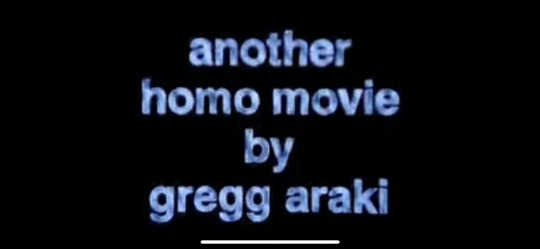
#this is one of the title cards from ‘totally fucked up’ from 1993#i watched it this past february when i was trying to watch a gay movie each day#of COURSE the homo movie maker worked on riverdale. OF COURSE!!!#shout out to tumblr user riverdalearthistory for putting the director in that post i just reblogged#i wouldnt have known otherwise#also totally fucked up is on youtube for free if u want to watch :)
6 notes
·
View notes
Note
is ur pfp from the another homo movie movie I dont remember it was like gay people by the guy who made the doom generation
omg ur right its from totally fucked up!! by gregg araki
10 notes
·
View notes
Text
feel lost and confused at the nowhere opening just calling it a gregg araki movie?? is it not a heterosexual movie by gregg araki?? an irresponsible movie by gregg araki??? another homo movie by gregg araki????
#might watch the living end after this depending on my attention span#anyway james duval I need you#also I need a 90s/early 00s wip SO BAD
4 notes
·
View notes
Text
thank u gregg araki for all ur movies about fucked up and problematic homos, truly the representation i crave
6 notes
·
View notes
Text
ok this is the faggiest thing i will ever ask but quickly yall do i get the st sebastian laptop sleeve or the "another homo movie by gregg araki" laptop sleeve
10 notes
·
View notes